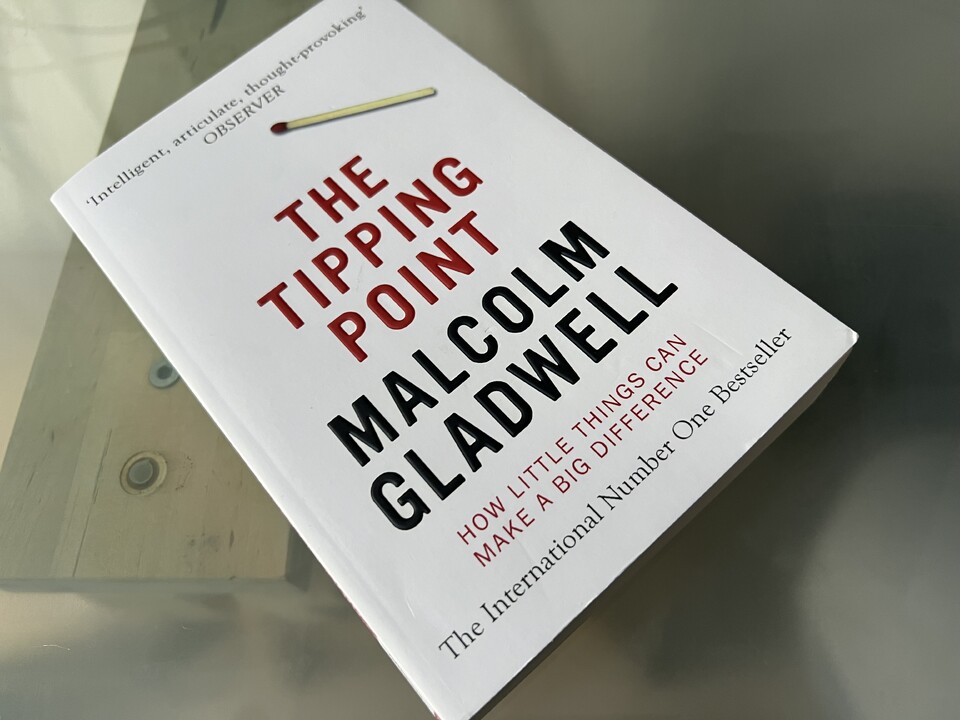The Tipping Point by Malcolm Gladwell is a thought-provoking exploration of how small changes can lead to significant effects in social behaviour offering insights into the dynamics of social epidemics and the pivotal role of certain individuals and factors in their occurrence.
Hush Puppies epidemic
Gladwell explores how certain products or trends can suddenly become wildly popular seemingly out of nowhere. The example of Hush Puppies shoes becoming a fashion trend in the 1990s despite being previously considered unfashionable is particularly striking. He attributes this phenomenon to the influence of a few key individuals, often referred to as "early adopters" or "trendsetters," who embrace the product or trend and spark its widespread adoption by others. This illustrates the concept of a tipping point, where a small change leads to a significant effect, transforming the perception and popularity of the product.
Paul Revere’s ride
Gladwell analyses Paul Revere's historic ride during the American Revolution to illustrate the role of "connectors" in spreading information and catalysing change. Revere, with his extensive network of contacts and social ties, was able to swiftly disseminate news of British troop movements, effectively mobilizing the colonial militias. This demonstrates the importance of well-connected individuals who serve as bridges between different social circles, enabling information to spread rapidly and widely.
He contrasts the rides of William Dawes and Paul Revere to highlight the importance of social influence and network connectivity in driving effective communication. While both men set out on similar missions to warn colonial militias of British troop movements, Revere's ride was far more successful in mobilizing the militias due to his extensive social connections and reputation as a trusted messenger. In contrast, Dawes, lacking Revere's social capital and network reach, was unable to galvanize the same level of response from the militias. This example underscores the critical role of connectors — individuals with broad social networks — in facilitating the spread of information and catalysing collective action during times of crisis.
Airwalk
Gladwell examines the marketing strategies employed by the shoe company Airwalk to illustrate the concept of "stickiness" — making an idea or product memorable and engaging. Airwalk successfully targeted a niche market of young skateboarders and snowboarders by sponsoring extreme sports events and aligning their brand with the rebellious and counter-cultural ethos of these subcultures. By effectively tapping into the aspirations and identities of their target audience, Airwalk was able to create a sense of authenticity and appeal that resonated with consumers, leading to the widespread adoption of their products.
Reducing crime in New York
Gladwell examines the strategies implemented to reduce crime in New York City in the 1990s, particularly focusing on the "broken windows theory" and the "tipping point" approach to law enforcement. By cracking down on minor offenses like fare evasion in the subway system, authorities were able to create an atmosphere of orderliness and deter more serious crimes. As part of this approach, efforts were made to clean up graffiti and address vandalism in public spaces.
This example underscores the ripple effect of small changes in behaviour and the role of context in shaping social dynamics.
One notable example Gladwell discusses is the "Clean Car Program" implemented by the New York City Transit Authority. By removing graffiti from subway cars promptly, the program aimed to send a message that vandalism would not be tolerated, thereby deterring further acts of crime and disorder. This proactive approach to maintaining public spaces played a crucial role in changing perceptions of safety and restoring a sense of order in the city.
The strength of weak ties
Gladwell emphasizes the importance of weak ties—connections between individuals who move in different social circles—in spreading information and facilitating social change. While strong ties are crucial for personal relationships and support networks, weak ties serve as conduits for new ideas and opportunities, linking disparate communities and fostering innovation and diffusion of information.
The importance of 150
Gladwell introduces the concept of Dunbar's number, which suggests that there is a cognitive limit to the number of stable relationships individuals can maintain, estimated to be around 150. This idea has implications for social organization and community cohesion, suggesting that groups tend to naturally fragment into smaller, more cohesive units once they exceed this threshold.
The Hutterites, a communal religious group living in the United States and Canada, typically organize themselves into colonies consisting of around 150 individuals, regularly splitting into separate groups once that number is hit.
Within a Hutterite colony, every member knows each other personally, fostering a strong sense of trust, cooperation, and shared identity. This intimate social structure enables efficient communication, decision-making, and resource allocation, contributing to the overall stability and resilience of the community.
Gladwell explores how this seemingly arbitrary number plays a crucial role in maintaining the tight-knit social fabric of these communities.
The power of hair salons
Gladwell explores the surprising influence of seemingly mundane environments like hair salons in shaping social trends and disseminating information. These settings serve as hubs of social interaction, where diverse individuals come together and exchange ideas, gossip, and opinions. After all, people may stay in a salon for an hour or more – a captive audience!
By tapping into the social networks that converge in these spaces, businesses and organizations can leverage them as platforms for spreading messages and catalysing social change.
The types of people crucial in a social epidemic
Malcolm outlines several key individuals who contribute to social epidemics:
Understanding the roles of these individuals is crucial in predicting and influencing social change.
Summary
Gladwell weaves together the previously mentioned examples and concepts to offer a comprehensive exploration of how ideas, behaviours, and trends spread through society. By illuminating the underlying dynamics of social epidemics and the pivotal roles played by individuals, networks, and contexts, he provides us with invaluable insights into the complexities of human behaviour and the mechanisms driving social change.
Working in Developer Relations, it is fascinating to learn more about how social epidemics occur and spread, particularly from a community management perspective. It is crucial to understand the do's and don'ts and what works and doesn't work when working with communities.
Understanding a communities motivations, being empathetic and embracing their culture is paramount when working with communities. Too many try to work with (or even worse - use) communities do not understand this and end up failing.
While I enjoyed 95% of the book, I didn’t enjoy how the dangers and addictiveness of smoking and drugs was downplayed or the ending chapter on suicide which whilst fascinating, sad, thought provoking and important does leave the reader a little sad.. (that is just a personal opinion – I completely understand the purpose of those parts of the book).
I will place the book appropriately in my all-time favourite book list.
For books similar to like this check out GoodBusinessBooks.com for your next read.
-- Lee
















